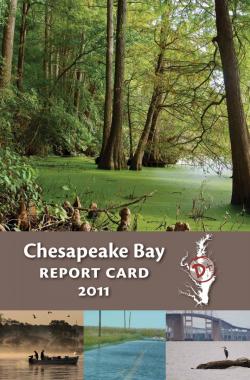BALTIMORE, MD (April 17, 2012)--A sequence of weather-related events including a wet spring, dry summer, and two devastating storms caused a decline in the overall health of the Chesapeake Bay in 2011. In an assessment conducted by EcoCheck scientists at the University of Maryland Center for Environmental Science and the National Oceanic and Atmospheric Administration, the nation’s largest estuary earned a grade of “D+" for 2011.
 The overall health of Chesapeake Bay declined for the second year in a row (to 38%) and was the second lowest since assessments began in 1986. The overall grade was a C- in 2010. Only two reporting regions, the Lower Western Shore (MD) and the Patapsco and Back Rivers, improved this year, while the rest remained the same or declined.
The overall health of Chesapeake Bay declined for the second year in a row (to 38%) and was the second lowest since assessments began in 1986. The overall grade was a C- in 2010. Only two reporting regions, the Lower Western Shore (MD) and the Patapsco and Back Rivers, improved this year, while the rest remained the same or declined.
"The spring rains and hot, dry summer followed by Hurricane Irene and Tropical Storm Lee led to poor health throughout Chesapeake Bay and its tributaries," said Dr. Bill Dennison of the University of Maryland Center for Environmental Science. "While we have been making considerable progress in various restoration activities, these results indicate we still need to do much more to reduce the input of nutrients and sediments from storm water runoff into the Bay."
The Chesapeake Bay's health is affected by many factors, including human activities, climate changes, and weather. Rainfall carries storm water runoff from cities, suburbs and farms to the Bay's tributaries and eventually to the Bay itself. Even as improvements are made in reducing the sources of pollution, higher rainfall and runoff can mask the effects of these improvements.
“The annual health of the Bay is influenced by the amount of rainfall and river flow that occurs over the entire year,” said EcoCheck scientist Caroline Wicks. "In 2011, river flow was well above average for the year, and not only from Hurricane Irene and Tropical Storm Lee. This high flow contributed to the poor grade that the Bay received this year.”
Scientists believe a sequence of natural events contributed to the poor health of the Bay in 2011, including:
- Spring Rains: A wet spring caused increased nitrogen and phosphorus pollution to wash off the land and into the Bay. This caused a spring algae bloom that decreased light levels in the water, hampering the growth of aquatic grasses.
- Hot, Dry Summer: Ideal conditions for algae blooms continued in the summer, resulting in low oxygen levels at the bottom of the Bay, where creatures like crabs survive.
- Hurricane Irene: Winds from Hurricane Irene (August 27–28) mixed the Bay waters, stirring up nutrients and affecting water clarity.
- Tropical Storm Lee: Rain from Tropical Storm Lee (September 7) brought tons of sediment and fresh water to the main stem of the Bay, further impacting water quality and leaving a layer of mud on the bottom.
Grades improved in only two reporting regions (Lower Western Shore (MD) and Patapsco and Back Rivers), declined in six regions, and remained unchanged in four. Lower scores were observed in the Patuxent River, Rappahannock River, James River, Lower Eastern Shore (Tangier Sound), Upper Bay, and Mid Bay.
"The report card clearly indicates that the Chesapeake Bay watershed is a dynamic ecosystem subject to severe weather events," said Nick DiPasquale, Director of the Chesapeake Bay Program. “The silver lining is that the Hopkins-UMCES study of 60 years of water quality data concluded that a decrease in the frequency and severity of dead zones in the Bay is the direct result of implementing measures to reduce nitrogen and phosphorus pollution. We know what works; we just need to do more of it."
The aim of this report card is to provide a transparent, timely, and geographically detailed assessment of 2011 Chesapeake Bay health. Chesapeake Bay health is defined as the progress of three water quality indicators (chlorophyll a, dissolved oxygen, and water clarity) and three biotic indicators (aquatic grasses, phytoplankton community, and organisms living on the bottom) toward scientifically derived ecological thresholds or goals. The six indicators are combined into one overarching Bay Health Index, which is presented as the report card overall score.
EcoCheck is a partnership program between University of Maryland Center for Environmental Science and National Oceanic and Atmospheric Administration. Each year, EcoCheck produces several report cards to assess the health of Chesapeake Bay waterways to enhance and support the science, management and restoration of Chesapeake Bay.
For more information about the 2011 Chesapeake Bay Health Report Card including region-specific data and downloadable graphics, visit Chesapeakebayreportcard.org.

